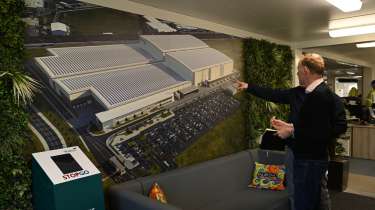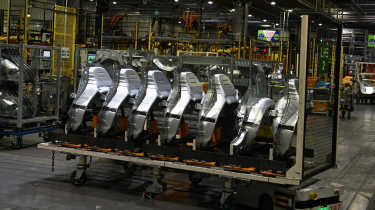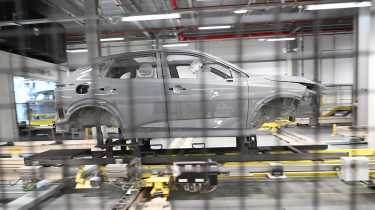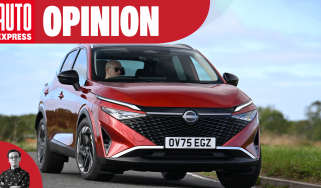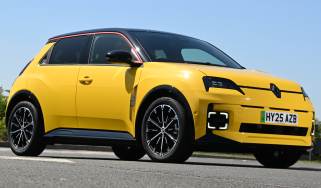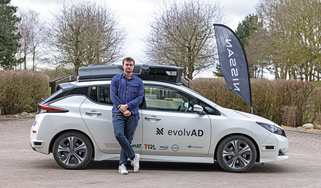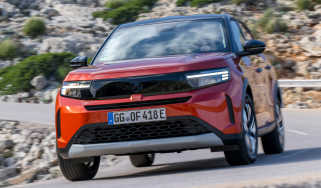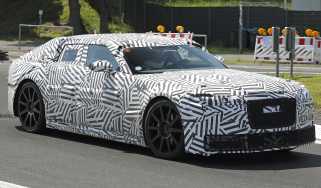Future of Nissan in the UK: new Gigafactory to power bold EV plans
Nissan is about to go from building the Qashqai hybrid to three fresh EVs in the UK over the next three years – all powered by a new gigafactory
The Nissan Leaf was a pioneer of mass-market EVs, so an all-new version is a very big deal indeed. But as you approach the Nissan Manufacturing UK (NMUK) site just commencing Leaf trial production, you realise everything about this sprawling car-making hub is a very big deal.
Workers’ cars back up all along the first A19 slip road as they enter the industrial park. We come off at the next junction, where new roads are under construction that lead to a mighty building that dominates the horizon. This is Plant 2, a gigafactory that expands Sunderland’s battery manufacturing capability eight-fold – and Auto Express is first to visit, as we tour the facilities manufacturing the third-generation Nissan Leaf.
The UK's biggest Gigafactory
The new gigafactory is a £1billion investment, owned and operated by Japanese battery maker AESC. It looks like one of those massive hangars where they manufacture space rockets, three-storeys high and at 360m, longer than London’s tallest building, The Shard, is high.
Nissan and AESC are so far ahead of the curve that this is their second gigafactory on the site; the first is a more modest single-storey building beside the car assembly plant.
“That was the first battery factory in Europe, never mind the UK, when it launched a decade ago,” says our AESC site guide Stuart Boyd, who previously worked in communications for Nissan.
Plant 1’s 1.8GWh (or 1.8 million kWh) annual output powered 282,000 British-built Leafs over its first two lifecycles. Each battery cell had a ‘pouch’ design, resembling a stiff, silver A4 envelope with terminals poking out the top.
Handling a pouch, it amazes me that the anode, electrolyte and cathode are all layered up in this wafer-thin vessel. Eight pouches would pack into a case to make a module, with the Mk2 Leaf having 24 modules in its 40kWh battery.
The new Leaf’s more flexible modules can accommodate eight, 16 or 24 pouches, enabling Nissan to offer a choice of battery sizes, yielding different ranges and price points. The Nickel Manganese Cobalt (NMC) pack’s energy density has also improved by 30 per cent. “Another big manufacturing change is we will produce our own electrodes, from a series of powders that come into the plant,” says Boyd.
It’s a shame we won’t see any production today: 1,600 construction workers are still swarming over the site in overalls, hi-vis jackets and hard hats, kitting out four long battery lines. The pressure is on to have production up and running by early summer, beginning the scale-up from small volumes to satisfy Nissan’s production plan – and having the batteries arrive just in time for fitting to the cars.
“We broadcast the sequence of the vehicles as they go into trim and chassis,” engineering director Guy Reid tells us later. “And by the time those cars have got all the way down to the battery-marriage facility, the batteries will have arrived in sequence on the back of an electric HGV, ready to be docked into the vehicle.”
Ultimately when Plant 2 is on stream, AESC’s 1,100 workers will be churning out 15.8GWh of batteries – likely sufficient for 150,000 electric vehicles a year. And the Plant 1 retrofit will add another 4.6GWh in time.
Inside the press shop
Press shops can be boomingly loud as dies punch metal into car parts under huge pressure, but it’s relatively quiet this lunchtime when we visit. Which means we can hear three-in-five words as Nissan engineering senior Alastair Facey walks us round. We’re accompanied by Dom Wells, a ‘seisan shutan’ which roughly translates as new model manager for the Leaf – or PZ1D to use the car’s catchy development title, a code we see plastered on boxes of trial components as we tour the press shop.
Wells has returned to the north-east having spent two years in Japan working on the project. The first task was to digitally model the new Leaf, speccing out all the components, associated costs and labour requirements. Next up was contracting those parts at the right price.
Nissan operates a mother/child assembly system and the global production engineering centre in Zama, Yokohama, is already making prototypes. So now the Newcastle University automotive engineering graduate is back in Sunderland helping NMUK follow suit.
Huge, rectangular presses will bang out 42 different panels for each new Leaf, one more than for a Qashqai and seven more than on a Juke. Towers of dies – the outlines that shape the steel blanks into parts under pressure – are stacked at one end of the hall, poised to be switched into place in less than a minute so the presses keep pounding.
The Leaf’s dies have been shipped from Japan and trial runs are underway. “We aim to start six months ahead [of series production],” reports Facey. “The presses can react differently under tonnage, so we’ll need to fine-tune to launch the Leaf to the best possible quality.”
Ensuring that quality control – carried out under hanging spotlights that could probably illuminate the nearby Stadium of Light, home to Sunderland football club – is the job of a team of expert workers, who scrutinise the parts. Any scrap metal is recovered and returned to suppliers for reuse.
The body shop
Sparks fly as body-shop robots knit disembodied parts together. Tom McCullough, a senior engineer on the new Leaf team, walks us past a rack of wheelhouses as he explains that framing (welding the sides, floor and roof into the body-in-white) is similar for EV and combustion models.
“A wheelhouse is broadly common to ICE and EV too: the shape of the panel and the quality of spot weld are much the same,” he explains. “But with an EV’s dash and floor, that’s not the case at all. And that’s why EV means lots of new investment.”
Nissan has pumped in £423million to plumb the Leaf into the second of NMUK’s two assembly lines. And that means 76 robots in seven new standalone welding cells for bespoke Leaf work. The dash panel differs due to the comparatively elongated cabin it borders and the need to package different parts – the air-con unit, not a combustion engine – beside it.
And for structural and styling reasons, Nissan has fitted laser brazing equipment – “like a big soldering iron”, chuckles McCullough – to get a better finish on the new Leaf’s swooping roof. “It’s better quality than a spot weld, which means we don’t have to fit parts over the top, saving weight and cost.”
McCullough and his team are currently working through the weekends to test the Leaf process, ensuring it doesn’t impact on the typical three-hour timeline to complete each car body.
Trim and chassis
After painting (interestingly, two-tone versions of the Leaf have to be taken aside, masked up and sprayed by hand) and drying, the new EV enters the final chapter of its assembly journey.
The 945m-long Line 2 fits out combustion and hybrid Jukes, petrol Qashqais and soon, the new Leaf. Its current production rate is 57.4 jobs per hour, so it’s almost a case of one born every minute. And this shouldn’t slow when the EV is in series production by the end of 2025. As doorless Nissans travel along the line, having parts such as a glass roof nonchalantly fitted in 10 seconds, we spy a fenced-off enclosure plastered in PZ1D branding to keep out prying eyes. This is the static training area for operatives to learn new Leaf processes.
On an overhead viewing platform, we see the biggest modification that has been made for the Leaf, the new battery-marriage station, and meet another seisan shutan, Andy Brennan.
New yellow carriers tailored for the Leaf elevate the body-in-white before the battery is hoisted into position. Underbody braces then slide across to hold the battery in place, before nine tools swing into action to apply 21 fixings.
“It’s possible to do 60 jobs per hour,” says Brennan. “This is the first line in Nissan capable of running at that speed – double the speed of the previous Leaf”.
Combustion cars also come through, but their engines and front sub-assembly are inserted further down the line. It’s the same story for the Leaf’s motors – front-wheel drive is standard, but an optional rear motor can be fitted between the new multi-link rear suspension for four-wheel drive. The evolving cars then have the wheels, seats and a dashboard fitted, ICE cars get fuelled and finally the doors go on, completing a process that takes around six hours in total.
It’s a procedure that’s been six years in the making, according to engineering director Guy Reid. “Detailed planning starts about four years before the launch date,” he says. “The new Leaf introduces significant changes because it’s on a new platform, CMF-EV. It has similarities with Ariya, which gave us some insights.
“Then we started to define the specifications to modify the plant and the significant changes required, particularly the battery-marriage facility and changes to the shops to carry the bodies around,” Reid explains.
At the same time, the engineers have to minimise disruption to existing production, by scheduling the biggest overhauls for winter or summer factory shutdowns. The new battery-installation station was added in winter 2023 and commissioned last summer. The upshot is that the UK’s largest car plant, one of Europe’s most productive and churning out 284,265 cars last year, is now supremely versatile.
“We have total flexibility in terms of ICE, hybrid and electric vehicles. And anything we put in is capable of building every car electric, 60 jobs an hour on Line 2,” Reid explains. “With the constant changes in government legislation, it's helpful that we have the capability to build ICE and hybrid vehicles as well as electric. So this plant is in a pretty good place to deal with any eventuality,” he tells us.
And before the new Nissan Leaf is even in full production, workers will make the next evolution to the line. During this summer’s lull, modifications will prepare the ground for the 2026 electric Juke. And a zero-emissions Qashqai won’t be far behind. Because for NMUK’s workers, the industrial music of production never ever stops.
Looking for a great deal on your next Nissan? Go here for all the best Auto Express deals on the Qashqai, Juke, and the all-electric Ariya...
Find a car with the experts


